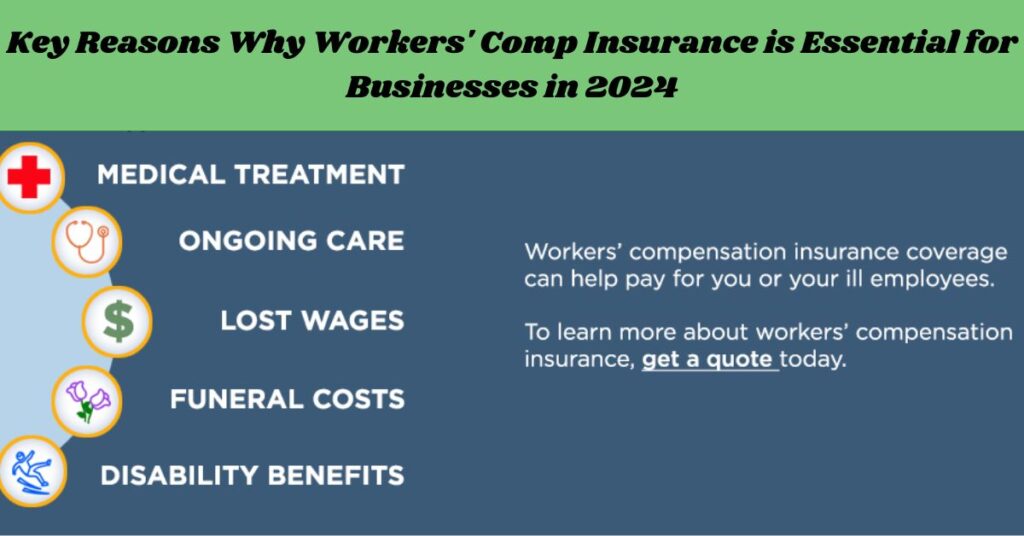
Contents
- 1 Key Takeaways:
- 2 Introduction to Workers’ Comp Insurance
- 3 Financial Implications of Workplace Injuries
- 4 Legal Requirements for Employers
- 5 Workers’ Comp as a Form of Employee Welfare
- 6 The Role of Workers’ Comp in Talent Retention
- 7 Workers’ Comp Insurance and Rising Healthcare Costs
- 8 Navigating the Claims Process
- 9 Choosing the Right Workers’ Comp Plan
- 10 Future of Workers’ Comp Insurance
Key Takeaways:
- I understand workers’ compensation’s direct and indirect benefits for financial stability and risk management.
- We are keeping up-to-date with the ever-changing landscape of legal requirements to remain compliant and stay ahead of potential fines.
- We recognize the positive impacts of an effective workers’ comp policy on employee morale and the overarching company culture.
- We are addressing the pressing issue of inflated healthcare costs through proactive workers’ comp insurance policies.
- They identify how enterprises can retain their skilled workforce by offering job-related injury and illness security.
Introduction to Workers’ Comp Insurance
Workers’ compensation insurance is a crucial aspect of the modern workplace as it serves a dual purpose. Firstly, it acts as a safety net for employees during tough times, and secondly, it shields employers from the potentially crippling financial blowbacks of on-site accidents and occupational diseases. An established workers’ compensation insurance plan indicates a business’s resilience and commitment to the well-being of its workforce.
Workers’ compensation insurance is a compliance requirement and embodies an employer’s dedication to employee security and trust. It is crucial to have a comprehensive risk management strategy that covers injured workers’ needs, including medical bills and compensation for lost wages due to incapacitation. This ensures that neither the employee nor the business bears the full brunt of an accident’s aftermath.
Financial Implications of Workplace Injuries
In today’s business environment, ensuring workplace safety is more crucial than ever. Workman’s compensation benefits provide essential employee protection by delivering workman’s compensation benefits in case of a job-related injury or illness. The financial consequences of workplace injuries affect a business in multiple ways. Apart from the immediate costs of medical care, companies must also deal with the hidden toll on their productivity and bottom line, such as increased insurance premiums and potential operational disruptions. Therefore, a sound workers’ comp policy acts as a buffer, protecting against these varied financial straits. Recent statistics demonstrate that strategic investments in workplace safety and workers’ comp insurance can significantly alleviate a company’s fiscal vulnerabilities. In the long run, the upfront costs of premiums pale compared to the expenses incurred from uncovered worker injuries, making workers’ comp insurance an essential fixture in a company’s financial planning apparatus.
Considering the indirect costs, such as retraining temporary replacements or the loss of seasoned workers, the incentives for maintaining an exhaustive workers’ comp plan are abundantly clear. Moreover, this form of insurance also serves as a testament to a company’s solvency and commitment to due diligence—qualities that can shore up investor confidence and fortify business partnerships.
Legal Requirements for Employers
The omnipresent threat of non-compliance looms over companies that undervalue workers’ comp insurance. Although variable across states, the mandate to institute such insurance is uniform in its core intent—to ensure businesses carry a minimum level of protection for their employees. Falling short of these legal benchmarks can result in hefty penalties and open the floodgates to costly litigation. Employers must keep abreast of state-specific requirements and stay informed of legislative changes to ensure regulatory alignment.
Regardless of location, employers must heed the call to provide adequate workers’ comp coverage, reflecting fairness and due care in their operations. This assurance of coverage builds a framework of trust and professionalism that supports a harmonious and compliant work environment.
Workers’ Comp as a Form of Employee Welfare
When thoughtfully implemented, workers’ comp insurance transcends its role as a mere safety net and becomes a cornerstone of workplace welfare. This form of insurance sends a clear message that employers are invested in their workforce’s long-term health and prosperity. This insurance policy promotes a culture of care and value by ensuring prompt and efficient handling of injury-related benefits essential to boosting employee morale and mental well-being.
Workers’ comp serves as a daily reassurance to employees that unforeseen mishaps will not jeopardize their livelihoods. Such security fosters a positive, cohesive, and motivated company culture where employees feel genuinely cared for and are more willing to engage and contribute meaningfully to their roles.
The Role of Workers’ Comp in Talent Retention
Fostering a solid corporate brand necessitates a keen eye on talent management, particularly in aspects that resonate with the workforce’s need for security. Workers’ comp influences an organization’s ability to attract and retain skilled workers. A comprehensive workers’ compensation package can be a significant draw in an era where job seekers scrutinize employer benefits as closely as salary offerings.
Job stability and workplace benefits rank highly on the list of criteria for job-seekers and currently employed individuals. A robust workers’ comp policy can determine an employee’s decision to stay with a business, as it demonstrates a long-term investment in their welfare. In this light, effective workers’ comp insurance isn’t just a regulatory formality—it’s a strategic tool for cultivating and retaining a capable and committed workforce.
Workers’ Comp Insurance and Rising Healthcare Costs
Employees who might face massive out-of-pocket expenses from work-related injuries are always concerned about rising healthcare costs. Workers’ compensation insurance is a crucial intermediary, affording them access to necessary medical treatments and therapies without financial devastation. Especially in light of prevalent healthcare inflation, this insurance assumes an even greater significance in shielding both parties from economic strain.
From a business perspective, managing healthcare costs effectively is paramount to sustaining a healthy bottom line. A strategic workers’ comp plan affords predictability in what could otherwise be volatile expense areas, streamlining budget planning and minimizing the risk of unforeseen financial blowouts resulting from employee healthcare needs.
The hallmark of an effective workers’ comp insurance plan is a transparent, equitable, fair, and smooth claims process. Ensuring that employees can navigate this system with ease is critical in maintaining business operations and ensuring rapid recovery and rehabilitation for the injured party. Streamlined claims management systems expedite the remedial process and reap dividends through reduced downtime and faster workforce reintegration.
Clear communication is the linchpin in the claims process. This includes educating employees on the proper steps to report incidents and lodge claims and maintaining open channels between the business, healthcare providers, and insurance carriers. This fosters a collaborative environment that benefits all stakeholders, embedding a sense of trust and care within the organizational structure.
Choosing the Right Workers’ Comp Plan
Just as no two businesses are identical, workers’ compensation plans must be tailored to meet the nuanced demands of various operations. From assessing risk exposure to understanding unique workforce dynamics, companies must carefully select their workers’ compensation policy. The ideal plan aligns closely with industry-specific risks, workforce demographics, and historical claims data, steering clear of under- and over-protection.
Future of Workers’ Comp Insurance
As we glance toward the future, it is clear that the realm of workers’ comp insurance will be reshaped by dynamic forces such as technological innovations, policy evolutions, and evolving expectations of workplace welfare. Companies that can forecast and adapt to these changes are better positioned to navigate labor insurance complexities, securing fiscal health and employee safety.
As the business world progresses through 2024 and beyond, the agility to adjust workers’ comp policies to the ever-shifting socio-economic landscape will be nothing short of vital.






